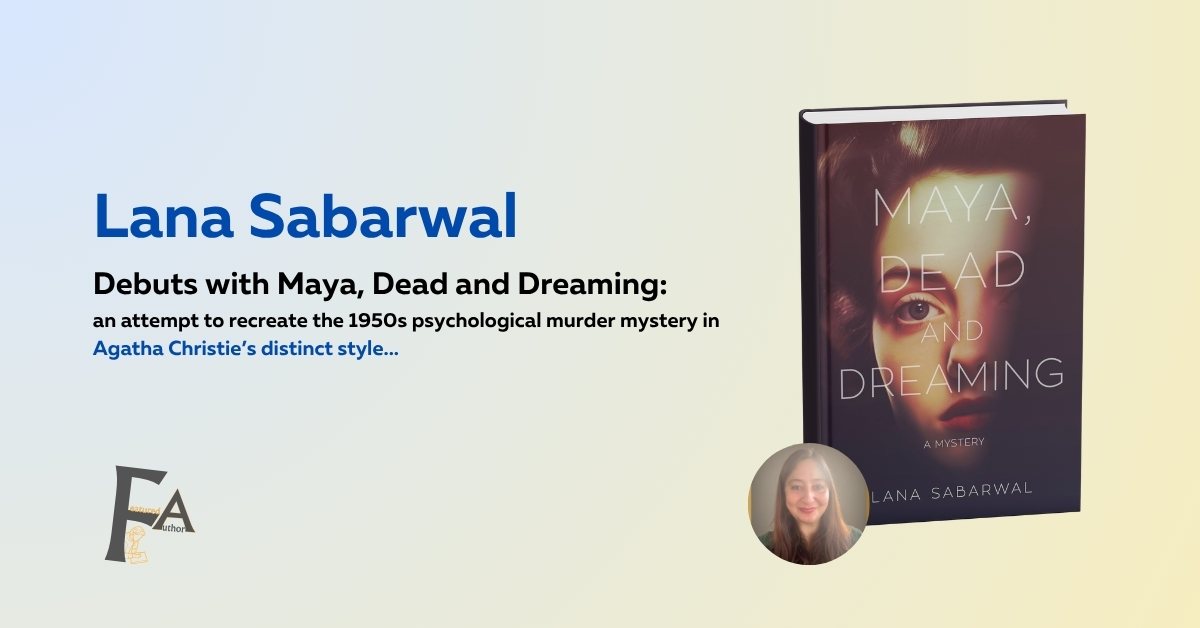The most striking element of Maya, Dead and Dreaming greets readers before they even turn the first page. The cover art, featuring a woman’s face half-illuminated and half-swallowed by darkness, perfectly encapsulates the novel’s central tension between truth and concealment. This visual metaphor extends throughout Sabarwal’s narrative, where characters exist in similar states of partial revelation. The title itself whispers duality: Maya is both dead and dreaming, suspended between finality and eternal unrest. Sabarwal understands what the great suspense writers know: that what remains unseen often terrifies more than what’s shown. This principle guides every aspect of her craft, from the carefully rationed clues to the psychological portraits of characters who are never quite what they seem.
Lana’s prose carries the weight of history without succumbing to nostalgia. Her 1950s Washington setting feels lived in rather than staged, with period details emerging organically through character interactions rather than exhaustive description. When Munna, the protagonist, fingers the edges of the anonymous letter that reignites the mystery, we don’t need paragraphs about paper quality to feel its significance. The economy of Sabarwal’s background in international development serves her well in this context. Like Christie before her, she understands that compelling mysteries are built on systems: of family, of social class, of unspoken rules that govern small towns. Where she diverges from tradition is in her willingness to let these systems remain partially opaque, resisting the tidy resolutions that often conclude golden age detective fiction.

The novel’s structure demonstrates Sabarwal’s mastery of suspense mechanics. She employs a dual timeline that mirrors the cover’s bifurcated image, alternating between the present investigation and flashbacks to Maya’s final days. This technique could feel gimmicky in lesser hands, but Lana Sabarwal wields it with precision, allowing each era to comment on the other. The past sequences gain power from what they withhold, while the present chapters thrum with the energy of secrets about to surface. Karenina, the psychoanalyst investigator, serves as the perfect bridge between these worlds, her clinical detachment gradually giving way to horrified fascination. Sabarwal’s decision to make her protagonist an academic rather than a professional detective proves inspired, allowing for deeper exploration of how we construct narratives around tragedy.
Critically, the novelist avoids the trap of over-explanation that plagues many debut mystery writers. The supernatural elements, particularly Munna’s haunting dreams of Maya, maintain their power because they resist straightforward interpretation. These sequences showcase Sabarwal’s prose at its most evocative, blending sensory details with psychological terror. When Munna dreams of a corpse that turns out to be herself, the moment lands with visceral impact precisely because Sabarwal doesn’t dissect its meaning. This restraint marks her as a writer who trusts her readers, a quality shared by the genre’s greats. If the novel falters, it’s in occasional overwriting of physical spaces, where the lush descriptions of Shogie’s geography momentarily stall the narrative momentum.
Another striking feature in Lana Sabarwal’s writing may be reflected in the fact that she pays tribute to writers she idolises, Jhumpa Lahiri and Agatha Christie. She attempts an ambitious literary alchemy, striving to blend Jhumpa Lahiri’s poignant explorations of cultural displacement and familial bonds with Agatha Christie’s meticulously plotted whodunits, creating a narrative that marries aching nostalgia with chilling secrets. The novel’s prose often shimmers with Lahiri-esque melancholy, particularly in its treatment of memory and identity. At the same time, its central mystery unfolds with Christie-like precision, complete with red herrings and a final revelatory confrontation. Sabarwal’s lyrical descriptions of 1950s Shogie and her nuanced character studies, especially of the Hickman family’s fractured dynamics, recall Lahiri’s emotional depth, while the gradual unspooling of Maya’s fate channels Christie’s gift for suspense. However, this hybrid approach risks alienating readers seeking either pure, fast-paced mystery or undiluted literary fiction; the deliberate pacing and layered introspection, though beautifully rendered, may frustrate those craving Christie’s trademark briskness, just as the genre conventions might disappoint readers drawn to Lahiri’s uncompromising realism. The novel succeeds most when these influences harmonise, as in Munna’s haunting dreams, which serve both as psychological portraits and clever clues, but occasionally strains under the weight of its dual ambitions, leaving some passages feeling neither wholly literary nor entirely suspenseful.
What ultimately elevates Maya, Dead and Dreaming beyond pastiche is Sabarwal’s nuanced understanding of human darkness. Like Highsmith, she recognises that the most terrifying monsters wear human faces, and like du Maurier, she knows how to make domestic spaces feel claustrophobic with secrets. The novel’s actual achievement lies in its balance of intellectual puzzle and emotional resonance. By the final act, the cover’s haunting image takes on new meaning: we realise we’ve been studying a portrait of grief itself, how it distorts and reveals in equal measure. For readers weary of predictable thrillers, Sabarwal offers something rare: a mystery that respects tradition while pushing it forward, and writing that shines even as it explores the darkest corners of the human heart.
You can get a copy of this novel from Amazon – click here to go to the Amazon book page.
Parakashtha for Featured Author
